|
The Dog Sport
Thousands of dog shows are held each year under American Kennel Club rules. At these shows, dogs are evaluated according to how well they match their breed standard. The standard will specify such characteristics as the shape and proportions of the head and body, the length and color of the coat, and appropriate personality for the breed. No dog perfectly matches the standard; the dogs are ranked relative to each other.
There are three kinds of dog shows: specialty shows, which means that only dogs of a certain breed compete, a group show, which means only dogs of a group (Toy, Terrier, Working, etc.) compete, and all-breed shows, which means that dogs of all breeds compete. The shows are put on by individual clubs, either specific breed, group, or all-breed clubs. The Columbia Terrier Association held its annual Terrier Group show on April 21, 2000. At the show many terrier breed clubs held their specialty shows, including the Airedale Terrier Club of Metropolitan Washington DC, the Scottish Terrier Club of the Greater Baltimore Area, the Fox Terrier Club of Maryland, and Potomac Skye Terrier Club.
(For more information on any clubs or shows, contact your local chapter.)
Training
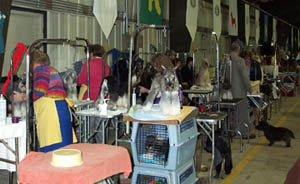 A dog may begin his or her training for the show ring while still a little puppy when the owner or breeder takes him or her to a show just to experience the noise and the activity and to get used to all the other dogs. Exposure to dog shows at an early age is excellent socialization, even for puppies that wonít be shown. The puppy is also taught at a young age how to walk in the leash used in showing and to keep his or her head up. A dog may begin his or her training for the show ring while still a little puppy when the owner or breeder takes him or her to a show just to experience the noise and the activity and to get used to all the other dogs. Exposure to dog shows at an early age is excellent socialization, even for puppies that wonít be shown. The puppy is also taught at a young age how to walk in the leash used in showing and to keep his or her head up.
At about four months of age, more formal training begins with a training class that mimics a dog show. The puppies learn to behave in the show ring, to be examined, and to stay focused on their owner or handler even though other dogs are close by. Puppies can begin showing at 6 months. They will normally continue to go to training classes or to practice sessions between shows to stay prepared.
 The owner or handler also needs to learn how to show the dog properly. They learn how to keep their dog under control, how to position the dog properly when it is standing, and how to move the dog around the ring at a walk or trot. The person must also learn how to keep the dogís attention. One way to do this is by using "bait". The bait is a piece of food that the dog really enjoys and that is only given during a show. The treat might be a piece of cheese, hot dog slices, or a chunk of cooked liver. The person may keep the bait in his or her pocket. Some people keep the bait in their mouth -- this keeps the dog looking at their face, which is better. The owner or handler also needs to learn how to show the dog properly. They learn how to keep their dog under control, how to position the dog properly when it is standing, and how to move the dog around the ring at a walk or trot. The person must also learn how to keep the dogís attention. One way to do this is by using "bait". The bait is a piece of food that the dog really enjoys and that is only given during a show. The treat might be a piece of cheese, hot dog slices, or a chunk of cooked liver. The person may keep the bait in his or her pocket. Some people keep the bait in their mouth -- this keeps the dog looking at their face, which is better.
Preparing
Preparation for attending a show begins well in advance of the show date. The dogís coat must be kept in proper condition through weekly grooming. Among the terriers, this requirement is especially true for the broken-haired terriers like the Airedales. These dogs must be hand stripped every week -- that is, the long hairs must be pulled out by hand using a stripping knife or simply the thumb and forefinger. (This sounds painful, but it is not. The hairs are brittle and break off without hurting the dog.)
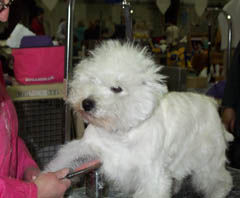
Last Minute Preparations
The day before the show and/or the morning of the show, the dog is washed and blown dry. Hair at the back of the ears, on the tail, muzzle, and feet is checked and trimmed as necessary. Right before the show, the dog is brushed out and any last minute touch-ups or stripping done. For example, with Scottish Terriers, a little styling gel is applied to keep their eyebrow hair under control.
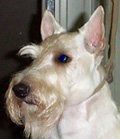
All Set
In the Ring
When it is time for a dog to compete in his or her class, the exhibitor will take the dog to the ring. (The exhibitor may be the owner of the dog, or a professional handler who shows the dog for the owner. Some professional handlers show their own dogs in addition to clientsí dogs.) The ring steward will tell the exhibitor the order the judge wants the dogs to line up. The order may be any order, or the order the dogs appear in the catalog. The exhibitors line up with their dogs in the proper order and stand or kneel along one side of the ring (which is actually square).
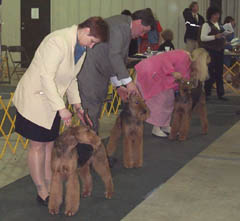
Getting the Right Stance
The exhibitors will begin by walking in a line with their dogs. In the ring, the dogs do not walk by the exhibitors in a "heel" position. Instead, they walk ahead of the exhibitor. Then the exhibitors stop, get their dog to stand in the correct position, and wait again in a line while the judge evaluates each dog.

The judge scans the lineup of dogs, then motions for the first exhibitor to move forward with his or her dog. The judge looks the dog over closely (the dog may be on a table for this examination). The judge also wants to see the dog in motion, so the exhibitor will trot around part of the ring with the dog trotting along side. This process is repeated for each dog. Then the judge will select first through fourth places for that class.
The Classes, Points, and Winners
At a show, there are several different classes for each breed: Puppies (usually divided into three classes -- 6 to under 9 months, 9 to under 12 months, and 12 to under 18 months), Novice (rarely used), Bred-by-Exhibitor, American-Bred, and Open. In addition, the males and females compete separately in these classes. Consequently, there will be two competitions for each class -- male Open and female Open, for example.
All the classes for the male dogs go first, beginning with Puppies 6 -- 9 months. As described earlier, a first through fourth place is awarded for each class. When all the classes for the males of a breed have finished, all the first place males compete against each other for the award of Winner's Dog. Once the Winnerís Dog is selected, the dog who placed second to him in his original class is brought into the ring, and the Reserve Winnerís Dog is selected. The Reserve Winner will get the points for the win if the Winner is disqualified.
Next, all the classes for the female dogs are judged, beginning with Puppies 6 -- 9 months. A first through fourth is awarded for each class. When all the females have finished, the first place female winners compete against each for the award of Winnerís Bitch. As with the male dogs, the second place female to the Winner is brought into the ring, and the Reserve Winnerís Bitch is chosen. There are always more females competing, so the competition is particularly stiff for the girls.
The selection of the Winnerís Dog and Winnerís Bitch is very important. Most of the dogs (males and females) competing are trying to earn points toward their championship, that is, a title that means the dog is an official American Kennel Club champion of record. To achieve this goal a dog must accumulate 15 points. The number of points that can be won at a show depends upon the size of the show (the number of dogs competing in the class) and also some restrictions to even out the scoring across breeds. The number of points that can be won at a show varies from 1 to 5 points. Wins of 3, 4, or 5 points are called "majors".
In order for a dog to become a champion, not only must he or she accumulate 15 points, but the points must include two major wins under two different judges. The total accumulation of points must also be given by three different judges.
The points are only given to the male and female dogs that are awarded Winner's Dog and Winner's Bitch, respectively. Consequently, for each breed at the show, only two animals will get any points toward their championship.

Once the two Winners have been selected, the judging for Best of Breed occurs. All of the champions of record for that breed at the competition and the two Winners are brought into the ring. The judge selects one as the Best of Breed. If neither of the two Winners is selected, the judge will select a Best of Winners from between the two. If the Best of Breed is one of the Winners, then that Winner automatically wins the Best of Winners. Then the judge will select a Best of Opposite sex (if the Best of Breed is a male, the judge will choose the best female; if the Best of Breed is a female, the judge will choose the best male).
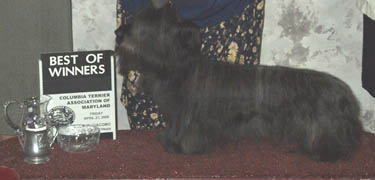
Best of Winners Skye Terrier
At a group show or an all-breed show, the next step is for the Best of Breed winners to compete against each other in their breed group (all the Terriers against each other; all the Sporting dogs; all the Toys, etc., for the seven groups). Awards are given for first through fourth, but only the first place winner of each group stays in the competition. At an all breed show, the group winners would then compete for the title of Best of Show.
The Show Life
A dog that is actively showing should achieve his or her championship within 2 years, unless some time is taken off for breeding or other reasons. An active exhibitor may attend 50 shows or so a year and may show more than one dog at a time (in different classes).
Clearly it is a labor of love -- up early in the morning (4 am or so) preparing for the show, travelling, packing and unpacking, the noise, commotion, hassles would quickly dampen the enthusiasm of someone who did not love showing. As one of the exhibitors said, "I really enjoy the competition. But I also enjoy the people I meet through the shows. You lose far more often than you win, so you have to be a good loser as well as a good winner, but itís worth it." Another exhibitor expressed her feelings like this: "I love to show my dog! I'm fairly new at it, but really enjoy it...I have used a handler for really
big shows. I only show for fun, so I don't really care too much about winning." And the dogs themselves seem to enjoy the process. One Best of Breed winner is, according to her owner, "a consummate show dog who loves to show off in the ring."
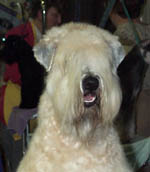
Relaxing after the Competition
Thanks to Cindy Altman and Ann P. Riley for their helpful information. Source: The Complete Dog Book: Official Publication of the American Kennel Club, Howell Book House, NY, 1985, pp. 22-25.
|



